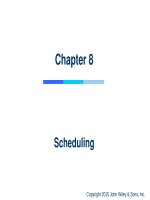Lecture Communication skill: Chapter 8 - Tracey Bretag, Joanna Crossman, Sarbari Bordia
Bạn đang xem bản rút gọn của tài liệu. Xem và tải ngay bản đầy đủ của tài liệu tại đây (269.77 KB, 47 trang )
Chapter 8
Business document
writing
Copyright 2009 McGraw-Hill Australia Pty Ltd
PPTs t/a Communication Skills, by Bretag, Crossman and Bordia
1
8-1
Learning objectives
On completion of this chapter students will know
how to:
• write a formal business letter using the full
block format
• differentiate between letters of inquiry, letters
of complaint, response letters and sales letters
• recognise the features and purposes of
communicating via email
• construct a standard email
• use a range of practices to ensure
successful business email communication.
Copyright 2009 McGraw-Hill Australia Pty Ltd
PPTs t/a Communication Skills, by Bretag, Crossman and Bordia
2
8-2
Business letters
Business letters are written for many reasons:
• to initiate action
• to inform
• to request
• to persuade.
Copyright 2009 McGraw-Hill Australia Pty Ltd
PPTs t/a Communication Skills, by Bretag, Crossman and Bordia
3
8-3
Steps to a successful
business letter
• To write a successful business letter follow
these steps:
–
–
–
–
Determine the purpose of your letter.
Write a plan.
Draft and redraft the letter.
Edit and proofread.
Copyright 2009 McGraw-Hill Australia Pty Ltd
PPTs t/a Communication Skills, by Bretag, Crossman and Bordia
4
8-4
Qualities of a
business letter
• A business letter should have the following
six qualities:
–
–
–
–
–
–
clarity
concreteness
completeness
conviction
conciseness
courtesy.
Copyright 2009 McGraw-Hill Australia Pty Ltd
PPTs t/a Communication Skills, by Bretag, Crossman and Bordia
5
8-5
Standard components of a
business letter
•
•
•
•
•
•
•
•
The letterhead (sender’s address)
The date
Receiver’s address
Salutation
Subject heading
Body of the letter
Sign off
Personal signature and name/title of sender
Copyright 2009 McGraw-Hill Australia Pty Ltd
PPTs t/a Communication Skills, by Bretag, Crossman and Bordia
6
8-6
Body of the letter
• The body of the letter should relate to the
subject heading.
• It should provide information logically
(i.e. in a sequence).
• Different issues should be discussed in
separate paragraphs.
Copyright 2009 McGraw-Hill Australia Pty Ltd
PPTs t/a Communication Skills, by Bretag, Crossman and Bordia
7
8-7
Style of letter
• Although there are several recognised styles
for a business letter, the full block style is
widely recognised.
• When working for an organisation ensure
that you are familiar with the in-house style
of the organisation, which may be a variation
of the full block style.
Copyright 2009 McGraw-Hill Australia Pty Ltd
PPTs t/a Communication Skills, by Bretag, Crossman and Bordia
8
8-8
Types of business letter
•
•
•
•
Letter of inquiry
Response to letter of inquiry
Purchase orders
Sales letter
Copyright 2009 McGraw-Hill Australia Pty Ltd
PPTs t/a Communication Skills, by Bretag, Crossman and Bordia
9
8-9
Letters of inquiry
• Provide a clear, specific question.
• Give a reason for the inquiry.
• Are polite, but not servile.
Copyright 2009 McGraw-Hill Australia Pty Ltd
PPTs t/a Communication Skills, by Bretag, Crossman and Bordia
10
8-10
Response to letter of
inquiry
• Use standard letter layout.
• Always use a subject heading.
• Begin by referring to the original inquiry
(be specific).
• Start with ‘Thank you for your inquiry …’
• Detail action you have taken in response to
the inquiry.
• If no action has (yet) been taken, still
respond immediately to the inquiry.
Copyright 2009 McGraw-Hill Australia Pty Ltd
PPTs t/a Communication Skills, by Bretag, Crossman and Bordia
11
8-11
Purchase orders
• Follow standard letter layout.
• Provide specific and complete information.
• Provide information about an acceptable
alternative.
• Give full instructions for delivery.
• Provide payment details.
• Start with ‘Please …’
Copyright 2009 McGraw-Hill Australia Pty Ltd
PPTs t/a Communication Skills, by Bretag, Crossman and Bordia
12
8-12
Sales letters
• Sales letters are different to other business
letters.
• They have two purposes: information and
advertising.
• Letters have to be persuasive but not
aggressive.
• A follow-up letter may be needed after a
certain period of time.
Copyright 2009 McGraw-Hill Australia Pty Ltd
PPTs t/a Communication Skills, by Bretag, Crossman and Bordia
13
8-13
Persuasive writing
• The AIDA principle:
A: Attention
I: Interest
D: Desire
A: Action
Copyright 2009 McGraw-Hill Australia Pty Ltd
PPTs t/a Communication Skills, by Bretag, Crossman and Bordia
14
8-14
Attention
•
•
•
•
•
•
Get the reader to pay attention.
State a problem that affects the reader.
Promise a benefit.
Use an emotional appeal.
Introduce your primary appeal.
Ask a question (that can’t be answered yes
or no).
Copyright 2009 McGraw-Hill Australia Pty Ltd
PPTs t/a Communication Skills, by Bretag, Crossman and Bordia
15
8-15
Interest
• Show the reader your answer to the problem
you raised in the first section.
• Provide a description of the reader enjoying
the benefits you mentioned in the first
section.
• Answer the questions you raised.
• Provide a clear transition from attention to
desire.
Copyright 2009 McGraw-Hill Australia Pty Ltd
PPTs t/a Communication Skills, by Bretag, Crossman and Bordia
16
8-16
Desire
• Move the reader from ‘like to have’ to ‘really
want’.
• Justify the reader’s desire with emotional
appeals (feelings) or rational appeals
(thinking ability) (e.g. clothes sold on the
basis of durability or fashion).
Copyright 2009 McGraw-Hill Australia Pty Ltd
PPTs t/a Communication Skills, by Bretag, Crossman and Bordia
17
8-17
Action
• Tell the reader what to do.
• Give a reason for acting now (e.g. free set of
steak knives).
• Provide aids (e.g. envelopes).
• Make reference to primary appeal to
convince the reader they are doing the right
thing.
Copyright 2009 McGraw-Hill Australia Pty Ltd
PPTs t/a Communication Skills, by Bretag, Crossman and Bordia
18
8-18
Receiver’s psychological
needs
• Letters cannot always provide good news
and fabulous opportunities!
• Sometimes letters are written to provide
unwelcome news.
• The following slides provide strategies for
writing letters that take into account the
receiver’s psychological needs.
Copyright 2009 McGraw-Hill Australia Pty Ltd
PPTs t/a Communication Skills, by Bretag, Crossman and Bordia
19
8-19
Make neutral comments
• Indicate some form of agreement that is very
general and will not alienate the reader.
• Let the reader know the subject of the letter
to add meaning to later information.
• Don’t imply ‘yes’ or ‘no’.
Copyright 2009 McGraw-Hill Australia Pty Ltd
PPTs t/a Communication Skills, by Bretag, Crossman and Bordia
20
8-20
Provide explanation
• Give your reasons for the decision (note that
reasons precede denial).
• Increase the chance of the reader
understanding and accepting your reasons.
• If possible, emphasise reasons that might
benefit the reader.
Copyright 2009 McGraw-Hill Australia Pty Ltd
PPTs t/a Communication Skills, by Bretag, Crossman and Bordia
21
8-21
Explain refusal
• Give clear and apparent reasons for refusal.
• Write refusal after a neutral statement
(e.g. ‘Thank you for your application. I regret
to inform you that your application was not
successful at this instance due to …’).
Copyright 2009 McGraw-Hill Australia Pty Ltd
PPTs t/a Communication Skills, by Bretag, Crossman and Bordia
22
8-22
End positively
•
•
•
•
End on an upbeat note.
Try to regain good feeling.
Can you suggest an alternative?
Show the reader you remain interested.
Copyright 2009 McGraw-Hill Australia Pty Ltd
PPTs t/a Communication Skills, by Bretag, Crossman and Bordia
23
8-23
What to avoid
• Avoid the following:
–
–
–
–
–
implying that the request will be granted
being overly apologetic
falling back on company policy
talking down to the reader
being so general that the reason does not relate
to the refusal
– emphasising the refusal more than is necessary
– making a direct negative statement of refusal
– using active voice (e.g. poor—‘I deny your
application for credit’, better—‘Credit was denied’)
Copyright 2009 McGraw-Hill Australia Pty Ltd
PPTs t/a Communication Skills, by Bretag, Crossman and Bordia
24
8-24
Letter of complaint
• A letter of complaint should be rational
rather than emotional.
• Give specific information about the issue
(e.g. the product, the particular fault).
• Be specific about how you want your
complaint dealt with (e.g. ask directly for a
refund or exchange).
• Be succinct.
• Avoid being rude or abusive.
• Stick to the facts.
Copyright 2009 McGraw-Hill Australia Pty Ltd
PPTs t/a Communication Skills, by Bretag, Crossman and Bordia
25
8-25









